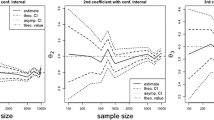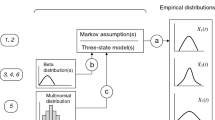Abstract
The best policy for an insurance company is that which lasts for a long period of time and is less uncertain with reference to its claims. In information theory, entropy is a measure of the uncertainty associated with a random variable. It is a descriptive quantity as it belongs to the class of measures of variability, such as the variance and the standard deviation. The purpose of this paper is to investigate the effect of inflation, truncation or censoring from below (use of a deductible) and truncation or censoring from above (use of a policy limit) on the entropy of losses of insurance policies. Losses are differentiated between per-payment and per-loss (franchise deductible). In this context we study the properties of the resulting entropies such as the residual loss entropy and the past loss entropy which are the result of use of a deductible and a policy limit, respectively. Interesting relationships between these entropies are presented. The combined effect of a deductible and a policy limit is also studied. We also investigate residual and past entropies for survival models. Finally, an application is presented involving the well-known Danish data set on fire losses.
Similar content being viewed by others
References
Abramowitz M, Stegun IA (1972) Handbook of mathematical functions. National Bureau of Standards. Applied Mathematics Series, No. 55
Asadi M, Ebrahimi N, Hamedani G, Soofi ES (2004) Maximum dynamic entropy models. J Appl Probab 41:379–390
Baxter LA (1989) A note on information and censored absolutely continuous random variables. Stat Decis 7:193–198
Belzunce F, Navarro J, Ruiz J, Aguila Y (2004) Some results on residual entropy function. Metrika 59:147–161
Block HW, Borges WS, Savits TH (1985) Age-dependent minimal repair. J Appl Probab 22:370–385
Cover TM, Thomas JA (1991) Elements of information theory. Wiley, New York
Cox DR (1972) Regression models and life tables. J R Stat Soc 34:187–202
Cox SH (1991) Bounds on expected values of insurance payments and option prices. Transactions of Society of Actuaries 43:231–260
Di Crescenzo A (2000) Some results on the proportional reversed hazards model. Stat Probab Lett 50:313–321
Di Crescenzo A, Longobardi M (2002) Entropy-based measure of uncertainty in past lifetime distributions. J Appl Probab 39:434–440
Ebrahimi N (1996) How to measure uncertainty in the residual life distributions. Sankhya 58:48–57
Ebrahimi N, Pellerey F (1995) New partial ordering of survival functions based on the notion of uncertainty. J Appl Probab 32:202–211
Ebrahimi N, Kirmani SNUA, Soofi ES (2007) Multivariate dynamic information. J Multivar Anal 98:328–349
Gupta RC, Gupta RD (2007) Proportional reversed hazard rate model and its applications. J Stat Plan Inference 137:3525–3536
Harris B (1982) Entropy. In: Kotz S, Johnson NL (eds) Encyclopedia of statistical sciences, vol 2. Wiley, New York, pp 512–516
Kluggman AS, Panjer HH, Willmot EG (2008) Loss models, from data to decisions, 3rd edn. Wiley, New York
McNeil AJ (1997) Estimating the tails of loss severity distributions using extreme value theory. ASTIN bull 27:117–137
Nadarajah S, Zografos K (2003) Formulas for Rényi information and related measures for univariate distributions. Inf Sci 155:119–138
Nair C, Prabhakar B, Shah D (2006) On entropy for mixtures of discrete and continuous variables. Computing Research Repository (CoRR). abs/cs/0607075
Pardo L (2006) Statistical inference based on divergence meaures. Chapman & Hall/CRC
Pigeon M, Denuit M (2011) Composite Lognormal-Pareto model with random threshold. Scand Actuar J 3:177–192
Resnick SI (1997) Discussion of the Danish data on large fire insurance losses. ASTIN Bull 27:139–151
Sankaran PG, Gleeja CL (2008) Proportional reversed hazard and frailty models. Metrika 68:333–342
Shannon CE (1948) A mathematical theory of communication. Bell Syst Tech 27:379–423
Vonta F (1996) Efficient estimation in a nonproportional hazards model in survival analysis. Scand J Statist 23:49–62
Vonta F, Karagrigoriou A (2010) Generalized measures of divergence in survival analysis and reliability. J Appl Probab 47(1):216–234
Zografos K (2008) On some entropy and divergence type measures of variability and dependence for mixed continuous and discrete variables. J Stat Plan Inference 138:3899–3914
Author information
Authors and Affiliations
Corresponding author
Rights and permissions
About this article
Cite this article
Sachlas, A., Papaioannou, T. Residual and Past Entropy in Actuarial Science and Survival Models. Methodol Comput Appl Probab 16, 79–99 (2014). https://doi.org/10.1007/s11009-012-9300-0
Received:
Revised:
Accepted:
Published:
Issue Date:
DOI: https://doi.org/10.1007/s11009-012-9300-0
Keywords
- Entropy
- Loss distributions
- Truncation and censoring
- Residual and past entropy
- Proportional hazards
- Proportional reversed hazards
- Frailty models




